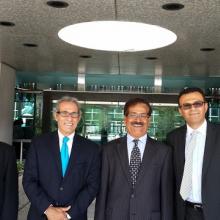A Vicious act of Terror, A Historic Verdict
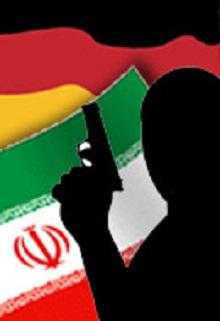 Compiled and edited by Sharif Behruz
Compiled and edited by Sharif Behruz
September 17, 2014
As the man with the black and green Sportino sports bag shouted in Persian: “You sons of bitches.” the first barrage of shots came from the Israeli made Uzi machine gun cloaked in the Woolworth bag. The first three of the twenty-one shots were fired while the Uzi was still in the bag.
The second assailant fired four times from a semi-automatic self-loading Spanish Llama X-A automatic pistol, executing an injured man lying on the floor at close range. Three men, all Kurdish nationals, died on the scene, another died in the hospital.
The assassination took place at 11:00 pm in the back room of Berlin’s Mykonos restaurant bar, Prager Strasse in the borough of Wilmersdorf on Thursday, 17 September of 1992. The targets were the leaders of the Kurdistan Democratic Party of Iran (PDKI) an armed Kurdish organization in Iran opposed to the clerical regime in Iran fighting for the rights of the Kurds in Iran. Dr. Sadegh Sharafkandi, then the leader of the PDKI, Fatah Abduli and Homayoun Ardalan his Europe and German deputies and Nouri Dehkordi an aid was among those killed in the attack.
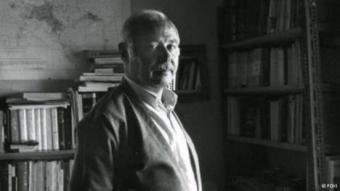 Sadegh- Sharafkandi
Sadegh- Sharafkandi “For friends of those killed the culprits were fixed from the outset: the theocratic and terrorist regime of Iran.” Speigel reported.
In the days and month following the assassination the First Criminal Division of the Berlin Regional Court commenced trials against three persons accused on the charge of joint murder and attempted murder and against two other accused, still at large, on suspicion of aid. Other accomplices, such as the Uzi gunman were still at large.
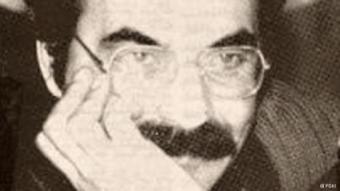 Nouri-Dehkordi
Nouri-DehkordiProsecutors suggested that Ali Fallahian, then head of Iran’s Intelligence Ministry, was the mastermind of the attack.
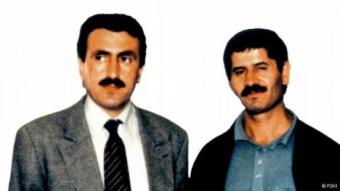 Right: Homayoun Ardalan Left Fatah Abdoli
Right: Homayoun Ardalan Left Fatah AbdoliAside from Abdol-Rahman Banihashemi who had flown from Iran ten days earlier to command the Mykonos operation, the mastermind and the facilitator of the attack, according to the Federal police investigations, was Kazem Darabi, 34 year old Iranian, former engineering student, and as the investigation revealed, lived in Berlin as greengrocers, operated an import and export business and was a leading figure at Berlin’s Imam Jafar Sadeqh mosque. Beyond the cover-up activities he was also the agent and hit-man for the MOIS.
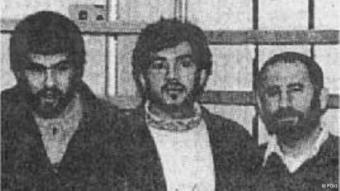 Terror Team
Terror TeamBeside the notorious IRGC and its abroad special operation division the Quds Force, the Lebanese Shiite terrorist group, Hezbollah or the Party of God, backed and financed by Iran’s regime was behind the attack. The group with close ties with the Iranian regime is responsible for numerous acts of terror against adversaries and the most kidnappings of Western hostages in Lebanon.
Because of such activities Darabi was targeted by the secret services for years. A Parliamentary Committee of inquiry in The Bundestag started enquiry to determine whether the Federal Constitutional Protection Bureau, through timely intervention, could have prevented the killings. Corresponding allegations set an alliance of deputies from the SPD and the Greens against the Bureau and its chief, then the Interior Minister Dieter Heckelmann.
The mullahs’ regime, as the Western intelligence assessments say, used the Lebanese Hezbollah to both spread the revolution – the founding principle of the regime of Islamic Republic in Iran – and to fight against opponents of the Islamic state. Hezbollah’s most senior operative, Imad Mughniyeh, killed in a car bomb in the outskirts of Damsacus in 2008 is believed to be the mastermind behind the organization and coordination of the Lebanese Hezbollah recruiters involved in the Mykonos Murder and string of other terrorist acts across the globe, including the AMIA Jewish Center bombing in Argentina in 1994.
By the summer of 1992 Darabi had received from his abettors in the MOIS the order to “liquidate” the Kurdish leadership during their stay in Berlin,” said
Speigel quoting Hans-Jürgen Förster of the Attorney General.
According to Speigel, the Kurdish side was even forewarned. The chief target of the attack in Berlin, Dr. Sadegh Sharafkandi had received clear indications of the planned terrorist act.
According to the information leaked and published by Speigel, in August, just one month before the attack, the Iraqi Kurdish leader Jalal Talabani was informed of the assassination plot, information that apparently came from his IRGC contacts and agents that were either in Iran or Iraqi Kurdistan.
In her insightful and detailed book, the Assassins of the Turquoise Palace, Roya Hakakian reconstructs this brutal crime. Furthermore, the crime investigations revealed some of the trained and experienced men whom Darabi recruited:
* Youssef Mohamad El-Sayed Amin provided security for the Mykonos operation, ensuring the hit team would not be disturbed as they sought out their targets in the restaurant. He was a veteran of Hezbollah and had received training alongside Abbas Rhayel in Iran. After his entry into Germany in 1989 and the subsequent application withdrawal and denial of his residency, German authorities, in June 19, 1992 ordered him to leave Germany by September 4, 1992. He was found guilty as an accessory to the four murders and was sentenced to 11 years in prison.
* Abbas Hossein Rhayel (aka Ragheb)was recruited by Darabi to be the second trigger man in the Mykonos operation. Rhayel was a Lebanese national who had joined Hezbollah and attended a Hezbollah training facility in Iran in 1985-1986 along with Youssef Amin. Rhayel was also convicted and sentenced to life in prison. The court found Rhayel guilty of firing at least some of the fatal shots.
* the Lebanese Atallah Ayad, who originally said to have designed later modified terror plan, as the prosecutor described, was as a former Amal militia member during the Lebanese civil war. He was arrested by the German authorities on December 10, 1992 and was held in custody until August 28, 1995.
*The remaining suspects – Abdol-Rahman Banihashemi, Haidar, Sabra, and Mohammad – escaped arrest. Banihashemi a veteran agent of the MOIS with experience in overseas operations directly reporting to then the Minster of Intelligence Ali Fallahian reportedly left Berlin immediately after the assassination and traveled through Turkey back to Iran. Farajollah Haidar, the driver for the getaway car for the assassination team escaped to Lebanon where he lived for some time before moving to Iran. He has since been reported to be working for the IRGC. Ali Dakhil Sabra procured the BMW car used by the assassination team for the operation. He had served in Hezbollah alongside Amin and Rhayel and came with them to Germany where he applied for asylum. On October 20, 1992 he withdrew his asylum application and flew to Lebanon. Mohammad, an Iranian national who has never been fully identified, acted as a spotter for the Mykonos team also left by the same route as Banihashemi.
Intelligence information from the Federal Intelligence Bureau provided the prosecutors a sufficient puzzle picture of the intricacies of the IRI regime:
Darabi first attracted the notice of German security officials in April 1982, when authorities in Dortmund issued a warrant for his arrest because of his alleged role in an attack on Iranian students opposed to Ayatollah Khomeini who lived in the University of Mainz international student dormitory. The students were violently assaulted by a mob of eighty-six Khomeini sympathizers. He was sentenced to probationary custody for a breach of the public peace.
He was a former leading official of the Union of Islamic Students’ Association in Europe, a student organization operated by the IRGC through the Ministry of Culture and Islamic Guidance and later MOIS. Members of the Iranian intelligence service in the Bonn Embassy, including diplomat Hassan Djavady, who was replaced in 1989 by fellow operative Morteza Gholami ordered him to spy on Iranian opposition members. Even Mohammad Amani-Farani, the Iranian Consul-General in Berlin used Darabi as a spy on the opposition.
The Iranian Intelligence Service, according to the indictment of the Attorney General, orchestrated the murder of Iranian Kurdish opposition leaders in Berlin. The investigation of the Mykonos operation was headed by German Federal Prosecutor Bruno Jost. The trial of the five Mykonos suspects opened on October 28, 1993 in the Berlin Court of Appeal. The trial lasted three and a half years.
Of the 246 Court sessions and hearing 176 witnesses, the testimonies of Abolghassem (Farhad) Mesbahi , former senior Iranian intelligence official known during the trial only as witness “C” and former Iranian President Abdolhassan Banisadr were crucial in the delivery of Mykonos Verdict in the April of 1997.
Former Iranian President Abdolhassan Banisadr testified that the Mykonos murders had been personally ordered by Ayatollah Sayyed Ali Khamenei, Iran’s Supreme Leader, and President Akbar Hashemi Rafsanjani. In an interview with IHRDC conducted in January 2007 Banisadr stated that he had confirmed this information with well-placed sources with direct knowledge of the inner workings of the IRI Ministry of Intelligence.
Banisadr also described for the court the role played by the IRI’s Special Affairs Committee in commissioning and overseeing political assassinations. He asserted that the recommendation to assassinate an opposition figure is usually first made by the Committee and then carried out with the consent of both Khamenei and Rafsanjani. Thus, he concluded, “The person who ordered this attack, under the current Iranian constitution and under Islamic law, can be no other than Khamenei himself.”
The Court found that the motives of the accused were political, because they advocated a fundamentalist regime in Iran and were ready to support their cause by murdering opposition leaders. In his 395-page decision, the presiding Judge, Frithjof Kubsch, pointedly noted that the trial had proved “Iran’s political leadership ordered the crime.” Kubsch did not identify any Iranian officials by name, but he noted that witness testimony and other evidence showed that Iran’s Special Affairs Committee had ordered the murders, and that the IRI Supreme Leader Seyed Ali Khamenei, then the President Akbar Hashemi Rafsanjani, foreign minister Ali Akbar Velayati and intelligence minister Ali Fallahian were all active members of that committee:
The previous statements make it clear, that the assassination of the leaders of the DPK-I (PDKI) under Dr. Sharafkandi, was neither the act of individuals, nor caused by conflicts within the opposition groups themselves. Rather, the assassination is the result of the work of the rulers in Iran.
The accused … had neither personal relationships with the victims nor any other interest that would lead to an independent resolution to plan such an act. Even Darabi would, due to his intelligence connections and his subordination to the political interests of the regime, not plan an assassination without an appropriate order, and because of logistical reasons, he would not even have been able to carry one out without outside help.
The evidence makes it clear that the Iranian rulers, not only approve of assassinations abroad and that they honor and reward the assassins, but that they themselves plan these kinds of assassinations against people who, for purely political reasons, become undesirable. For the sake of preserving their power, they are willing to liquidate their political opponents.

